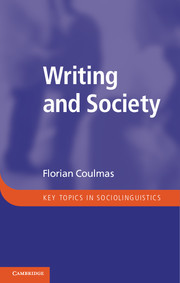Book contents
- Frontmatter
- Contents
- List of illustrations
- List of tables
- Preface
- Acknowledgements
- 1 The tyranny of writing and the dominance of vernacular speech
- 2 The past in the present and the seeds of the public sphere
- 3 Written and unwritten language
- 4 Literacy and inequality
- 5 The society of letters
- 6 Writing reform
- 7 Writing and literacy in the digitalized world
- Notes
- Bibliography
- Index
3 - Written and unwritten language
Published online by Cambridge University Press: 05 February 2013
- Frontmatter
- Contents
- List of illustrations
- List of tables
- Preface
- Acknowledgements
- 1 The tyranny of writing and the dominance of vernacular speech
- 2 The past in the present and the seeds of the public sphere
- 3 Written and unwritten language
- 4 Literacy and inequality
- 5 The society of letters
- 6 Writing reform
- 7 Writing and literacy in the digitalized world
- Notes
- Bibliography
- Index
Summary
The transition of a language to written recording involves profound transformations, one of the most salient being the reduction of the fluctuation characteristic of the spoken word in favour of a congelation of the used registry.
(Cardona 2009: 132)Linguistic resources
The majority of the languages of the world have never been written, but the vast majority of the world's population learn to read and write. This implies that virtually everywhere the division of communicative labour between the oral and written modes corresponds to specific sociolinguistic arrangements that assign different functions to different languages. One way of looking at these arrangements is by considering languages as resources. Two dimensions for systematizing linguistic resources are stipulated here: (1) the reference group, and (2) a language's functional potential. As regards the first dimension, the question is ‘Whose resources?’, whereas the second asks: ‘What kind of resources?’ The reference group is identified in terms of size and group-defining features, ranging in descending order from the all-encompassing to the minimal unit: world, nation state, ethnicity, organization, family and individual. The functional dimension is subdivided into various kinds of resources: intellectual, cultural, emotional – symbolic, social and economic. Using these two dimensions, a matrix can be set up as illustrated in Table 3.1.
- Type
- Chapter
- Information
- Writing and SocietyAn Introduction, pp. 39 - 59Publisher: Cambridge University PressPrint publication year: 2013



